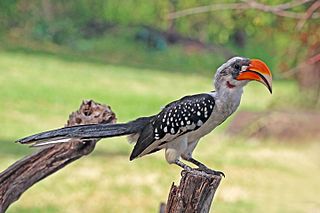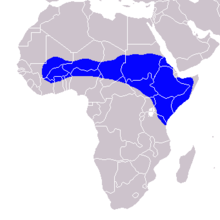
Hornbills are birds found in tropical and subtropical Africa, Asia and Melanesia of the family Bucerotidae. They are characterized by a long, down-curved bill which is frequently brightly coloured and sometimes has a horny casque on the upper mandible. Hornbills have a two-lobed kidney. They are the only birds in which the first and second neck vertebrae are fused together; this probably provides a more stable platform for carrying the bill. The family is omnivorous, feeding on fruit and small animals. They are monogamous breeders nesting in natural cavities in trees and sometimes cliffs. A number of mainly insular species of hornbill with small ranges are threatened with extinction, mainly in Southeast Asia.

Tockus is a genus of birds in the hornbill family, Bucerotidae, which are native to Africa.

The southern ground hornbill is one of two species of ground hornbill, both of which are found solely within Africa, and is the largest species in the hornbill order worldwide. It can be found in the southern regions of Africa, ranging from Kenya to South Africa. Within these regions, they inhabit both woodlands and savannas. The other species of the genus Bucorvus is the Abyssinian ground hornbill, B. abyssinicus.

The red-billed hornbills are a group of hornbills found in the savannas and woodlands of sub-Saharan Africa. They are now usually split into five species, the northern red-billed hornbill, western red-billed hornbill, Tanzanian red-billed hornbill, southern red-billed hornbill and Damara red-billed hornbill, but some authorities consider the latter four all subspecies of Tockus erythrorhynchus.

The African grey hornbill is a member of the hornbill family of mainly tropical near-passerine birds found in the Old World. It is a widespread resident breeder in much of sub-Saharan Africa and the southwest of the Arabian Peninsula. The African grey hornbill has escaped or been deliberately released into Florida, USA, but there is no evidence that the population is breeding and may only persist due to continuing releases or escapes.

The Mindanao hornbill, also known as the Mindanao tarictic hornbill, is a medium-small species of hornbill found in the canopy of rainforests on Mindanao, Dinagat, Siargao and Basilan in the southern Philippines. All five Philippine tarictics were once considered a single species. Its population declining due to habitat destruction, hunting and the illegal wildlife trade.

Von der Decken's hornbill is a hornbill found in East Africa, especially to the east of the East African Rift, from Ethiopia south to Tanzania. It is found mainly in thorn scrub and similar arid habitats. Jackson's hornbill is often treated as a subspecies of it. It was named after the German explorer Baron Karl Klaus von der Decken (1833–1865).

The great hornbill, also known as the concave-casqued hornbill, great Indian hornbill or great pied hornbill, is one of the larger members of the hornbill family. It occurs in the Indian subcontinent and Southeast Asia. It is predominantly frugivorous, but also preys on small mammals, reptiles and birds. It has been listed as Vulnerable on the IUCN Red List since 2018. It is known to have lived for nearly 50 years in captivity. Due to its large size and colour, and importance in many tribal cultures and rituals, the Government of Kerala declared it as the official Kerala state bird. It is also the state bird of Arunachal Pradesh.

Bucerotiformes is an order of birds that contains the hornbills, ground hornbills, hoopoes and wood hoopoes. These birds were previously classified as members of Coraciiformes. The clade is distributed in Africa, Asia, Europe and Melanesia.

The Sulawesi hornbill, also known as the Sulawesi tarictic hornbill, Temminck's hornbill or Sulawesi dwarf hornbill, is a relatively small, approximately 45 cm (18 in) long, black hornbill. The male has a yellow face and throat, and yellowish horn bill with black markings. The female has all-black plumage and a darker bill.

The writhed hornbill, also known as the Mindanao wrinkled hornbill, is a species of hornbill in the family Bucerotidae. It is endemic to primarily lowland forests on the Philippine islands of Mindanao, Dinagat and Camiguin Sur. It formerly included the Walden's hornbill as a subspecies, but unlike that species, both sexes of the writhed hornbill have orange-red throat and peri-ocular skin. The writhed hornbill is threatened by habitat loss and hunting.

The Samar hornbill is a species of hornbill in the family Bucerotidae. It is found in forests on the islands of Samar, Calicoan, Leyte and Bohol in the east-central Philippines. As is the case with all Philippine tarictic hornbills, it has been considered a subspecies of Visayan hornbill Alternatively, it is considered a subspecies of Mindanao hornbill.

The Eastern yellow-billed hornbill, also known as the northern yellow-billed hornbill, is a species of hornbill in the family Bucerotidae. It is found in Djibouti, Eritrea, Ethiopia, Kenya, Somalia, South Sudan, Tanzania, and Uganda. It resembles the southern yellow-billed hornbill, but has blackish skin around the eyes.

The western dwarf hornbill is a species of hornbill in the family Bucerotidae. It is widely spread across the African tropical rainforest. It was formerly considered to be conspecific with the eastern dwarf hornbill with the English name "black dwarf hornbill".

Jackson's hornbill is a species of hornbill in the family Bucerotidae. It is only found in North West Kenya and North East Uganda. Except for the dense white spots on the wing-coverts, it resembles, and is often considered a subspecies of, Von der Decken's hornbill.

The western red-billed hornbill is a species of hornbill in the family Bucerotidae. It is found from Senegal and Gambia to southern Mauritania and western Mali. There are five species of red-billed hornbills generally recognized now, but all five were once considered conspecific. Some authorities still categorize the group as Tockus erythrorhynchus with the remaining four as its subspecies

The southern red-billed hornbill is a species of hornbill in the family Bucerotidae, which is native to the savannas and dryer bushlands of southern Africa. It is replaced by a near-relative, the Damara red-billed hornbill, in the arid woodlands of western Namibia. All five red-billed hornbills were formerly considered conspecific.

The Damara red-billed hornbill is a species of hornbill in the family Bucerotidae. It is found in southwest Angola and northern Namibia. All five red-billed hornbills were formerly considered conspecific.

The Tanzanian red-billed hornbill is a species of hornbill in the family Bucerotidae. It is found in central Tanzania and was discovered by Robert Glen and Sue Stolberger in Ruaha National Park All five red-billed hornbills were formerly considered conspecific.
Mediorhynchus mattei is a species of acanthocephalan, a parasitic worm, found in the digestive tract of a bird, the northern red-billed hornbill Tockus erythrorhynchus. Male worms are 2-3 cm in length, females are 3-11 cm in length. It was described in 1982; its name honours French zoologist Xavier Mattei.





















